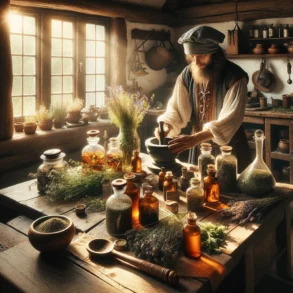Traditional European Herbal Remedies
You’re about to embark on a fascinating journey through the art of traditional European herbal remedies and practices in this article. With a rich history seeped in ancient wisdom, these practices have permeated various societies and cultures across Europe for centuries. You will become privy to how numerous plants, herbs, and roots have played a vital role in maintaining health and wellbeing, and how these natural medicines have stood the test of time. By traversing this enchanting path, you might just discover a profound respect for the wisdom of the ages and the healing power of the natural world around you.

Understanding Herbal Remedies
You might have heard about herbal remedies in passing conversations or skimmed through some articles mentioning them. But what are they really?
Historical background of herbal remedies
Herbal remedies have been used by humans since the dawn of civilization. Archaeological investigations have found evidence of the use of plants for medicinal purposes in Neanderthal burial sites, which date back as far as 60,000 years ago. Ancient texts from civilizations such as Egypt, China, India, and Greece provide further proof of the widespread practice of herbal medicine.
Principles behind herbal remedies
At its core, the principle behind herbal remedies is simple – use parts of a plant to cure ailments. It might be the leaves, roots, bark, seeds or flowers. Depending on the ailment, these parts could be used fresh, dried, boiled into a tea, made into a poultice or processed in various other ways for internal or external use. The belief is that each plant carries healing properties in one form or another.
Common misconceptions about herbal remedies
Despite their long history, misconceptions about herbal remedies persist. Some people mistakenly equate “natural” with “safe,” ignoring the possibility that some herbs can be toxic if used inappropriately. Another common misconception is that herbal remedies are a lower form of medicine, whereas in reality, they are the basis on which many modern medicines are built.
Traditional European Herbal Remedies
When talking about European herbal remedies, the diversity of the continent is represented in the diverse use of plants for healing.
Overview of traditional European herbal remedies
Herbs have been used for medicinal purposes in Europe for thousands of years. These remedies were traditionally passed down through families, or from master herbalists to apprentices.
Regional differences in herbal remedies
From the sunny Mediterranean to the colder Northern European regions, the different climates and landscapes in Europe have given rise to unique regional herbal remedies, each with their characteristic herbs.
Prominent herbs used in European remedies
Some of the prominent herbs in European remedies include St. John’s wort used for depression, valerian root for sleep disorders, and peppermint for digestion issues. These herbs constitute just a few examples of the vast herbal repertoire.
Herbal Remedies in Ancient Europe
The use of herbal remedies in ancient Europe was quite prevalent among cultures such as the Greeks, Romans, Celts, and Nordics.
Use of herbal remedies in ancient Greece
In ancient Greece, herbalism was a well-respected practice. Dioscorides’ De Materia Medica, written in the first century AD, is one of the oldest known herbals detailing Greek knowledge about the uses of plants for healing.
Roman contribution to herbal remedies
The Romans borrowed heavily from the Greeks but also made their own contributions. Pliny the Elder, for example, described the medicinal applications of around 800 plants in his Naturalis Historia.
Herbal practices in Celtic and Nordic cultures
In Celtic and Nordic cultures, herbalism was closely tied to spirituality. Certain herbs were associated with gods and goddesses or used in religious ceremonies and rituals.
Herbal Remedies in Medieval Europe
Despite the challenges, herbal remedies endured during Medieval times and played a critical role in health practices.
Role of Monasteries in preserving herbal knowledge
Monasteries were the main centers of learning in Medieval Europe. Monks cultivated gardens filled with healing herbs and copied ancient medicinal texts, ensuring the preservation of this knowledge.
Folk remedies and witchcraft accusations
However, there was a darker side to herbal practices in this time. Folk healers who used herbs were often accused of witchcraft, leading to widespread persecution.
Impact of the Black Plague on herbal remedies
The Black Plague sparked a renewed interest in herbal remedies as people desperately sought cures. Plants such as yarrow, mustard, and onion were used to combat this deadly disease.

Herbal Remedies in Renaissance Europe
The era of the Renaissance heralded a renewed interest in the exploration and scientific study of plants.
Scientific exploration of herbs
Botanical gardens flourished during the Renaissance, allowing herbalists to study and classify a wide variety of plants.
Newly discovered herbs from colonial explorations
Explorers returning from the New World brought a variety of new plants to Europe, expanding the available repertoire of herbs for medicinal use.
Herbs in alchemy and magic
Interestingly, during this time, herbalism often overlapped with alchemy and magic. Many herbs in Europe were believed to have mystical properties in addition to their healing ones and were used in spells and potions.
Modern European Herbal Practices
Modern Europe continues to uphold its herbal traditions, though the practices have evolved and transformed over time.
Continued use of traditional remedies
Traditional remedies continue to be used widely alongside modern medicine. In many parts of Europe, it’s common to turn first to herbal teas or poultices for minor ailments.
Incorporation into modern medicine
Many modern medicines have their roots in traditional herbal remedies. For example, salicylic acid, the active ingredient in aspirin, comes from willow bark – a pain remedy used by the ancient Greeks.
Contemporary herbal remedy businesses
Today, herbal remedies are a huge industry in Europe, with numerous businesses offering a wide array of herbs and herbal products for various health concerns.

Scientific Studies on European Herbal Remedies
Herbal remedies, once an area often neglected by the scientific community, has gained substantial attention in recent years.
Clinical trials and research on efficacy
Many European herbs are currently under clinical trials, with researchers examining their effectiveness in treating a variety of conditions, from chronic illnesses to common health complaints.
Safety issues and contraindications
While herbs are generally believed to be safe, they can also have side effects and can interact with other medications. Research is ongoing to provide clearer safety profiles for these herbs.
Pharmacological potentials
The pharmacological potential of herbs is immense, with scientists constantly discovering new compounds with therapeutic properties from the plant world.
Law and Regulation on European Herbal Remedies
The herbal remedy industry in Europe, like anywhere else, is subject to laws and regulations designed to protect consumers.
Current laws and guidelines
There are stringent EU laws and guidelines that govern the production, labeling, and sale of herbal products to ensure quality and safety.
Regulation of herbal remedy businesses
Businesses dealing with herbal remedies have to comply with these regulations and are subject to routine checks and inspections.
Legal challenges and debates
Notwithstanding, there have been substantial debates and legal challenges revolving around the regulation of herbal medicines, often centered on issues like quality assurance and proof of efficacy.
Contributions of European Herbal Remedies to Global Practices
The European tradition of herbal remedies has had a significant influence on global practices.
European influence on other herbal traditions
Many healing practices across the globe have incorporated European herbs and remedies. For example, in the practice of Ayurveda in India, European herbs like rosemary and mint have found their place.
Adoption of European herbs in other cultures
Likewise, European herbs have been adopted by other cultures and incorporated into their traditional medicines. Ginseng, for example, although originally an Asian herb, is now widely grown and used in Europe.
European herbs in the global pharmaceutical industry
Numerous modern pharmaceuticals that are used globally have their origins in European herbs, demonstrating their significant contributions to worldwide health practices.
The Future of European Herbal Remedies
With a past so richly intertwined with herbs, it’s certain that the future of European herbal remedies holds promise.
Advancements in research and understanding
The future will undoubtedly bring further advancements in the understanding of herbs, their medicinal properties, and how best to use them to support health and wellbeing.
Potential threats to traditional herbal practices
However, we must also be aware of potential threats, such as the loss of traditional knowledge in the face of scientific domination or the risk of overharvesting wild herbs.
Sustainability of herbal resources
For herbal remedies to have a sustainable future, it’s vital to ensure the conservation of plant species and the responsible use of herbal resources.
Exploring traditional European herbal remedies and practices offers a fascinating journey through time— a testament to the enduring power of nature’s pharmacy. Despite advancements in modern medicine, the humble herb continues to be an intrinsic part of the European healthcare system.
Traditional European Herbal Remedies
If you’re interested in exploring traditional European herbal remedies, the following websites offer a wealth of information, historical context, and practical advice:
- Hearthside Healing dives into the intricacies of Traditional European Herbalism (TEM), highlighting the historical development of herbalism in Europe from its roots in ancient Greece and Egypt to its evolution into the age of enlightenment. This site delves into the philosophical underpinnings of TEM, such as the humoral theory proposed by Hippocrates and the subsequent elaboration by Galen, emphasizing the holistic approach to health that balances bodily humors. It also explores the spiritual and practical applications of herbs in ancient and medieval European societies. Discover more at: www.hearthsidehealing.com
- Annie’s Remedy offers a comprehensive guide to traditional herbs of Europe, covering a wide range of plants from the ancient Greek and Roman eras to the present. Each herb is described in detail, including its historical uses, medicinal properties, and practical applications in modern herbalism. The website provides a rich resource for those interested in the herbal traditions of Europe, including how to use these herbs for various health conditions. Learn more at: www.anniesremedy.com
- Healthy Hildegard focuses on Traditional German Herbal Medicine, tracing its roots back to ancient Germanic culture and highlighting its evolution through the ages. It places a particular emphasis on Hildegard of Bingen, a medieval nun whose writings significantly contributed to the herbal and natural health knowledge of her time. The site explores the integration of modern knowledge and scientific methodology with historical herbal practices, offering insights into the holistic approach of German herbal medicine that includes the mind, body, and spirit. More information can be found at: www.healthyhildegard.com
These websites provide a fascinating glimpse into the rich history and practical applications of traditional European herbal remedies, offering a valuable resource for anyone interested in herbalism, historical medicine, or natural healing practices.
